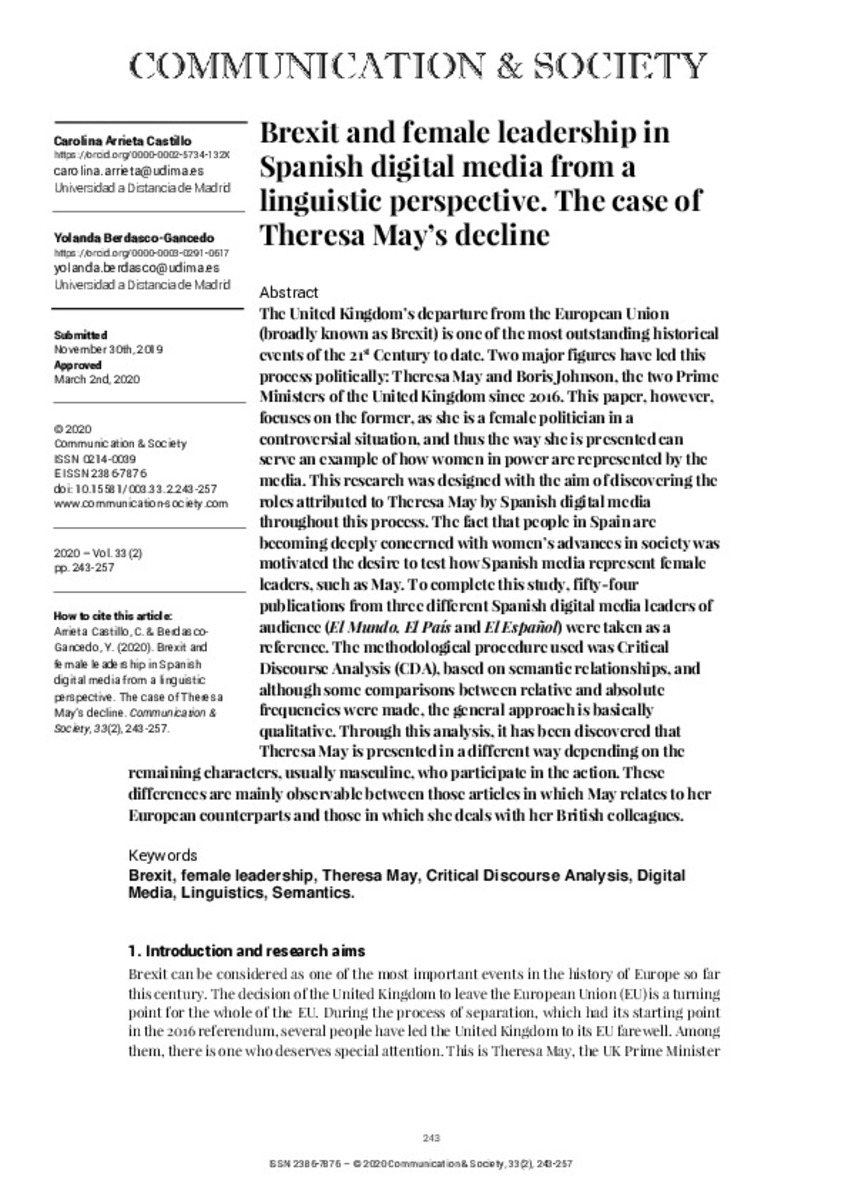Full metadata record
| DC Field | Value | Language |
|---|---|---|
| dc.creator | Arrieta-Castillo, C. (Carolina) | - |
| dc.creator | Berdasco-Gancedo, Y. (Yolanda) | - |
| dc.date.accessioned | 2020-04-20 | - |
| dc.date.accessioned | 2021-11-09T08:27:37Z | - |
| dc.date.available | 2021-11-09T08:27:37Z | - |
| dc.date.issued | 2020 | - |
| dc.identifier.citation | Arrieta-Castillo, C. (Carolina); Berdasco-Gancedo, Y. (Yolanda). "Brexit and female leadership in Spanish digital media from a linguistic perspective. The case of Theresa May’s decline". Communication & Society. 33 (2), 2020, 243 - 257 | es |
| dc.identifier.issn | 2386-7876 | - |
| dc.identifier.uri | https://hdl.handle.net/10171/62366 | - |
| dc.description.abstract | The United Kingdom’s departure from the European Union (broadly known as Brexit) is one of the most outstanding historical events of the 21<sup>st</sup> Century to date. Two major figures have led this process politically: Theresa May and Boris Johnson, the two Prime Ministers of the United Kingdom since 2016. This paper, however, focuses on the former, as she is a female politician in a controversial situation, and thus the way she is presented can serve an example of how women in power are represented by the media. This research was designed with the aim of discovering the roles attributed to Theresa May by Spanish digital media throughout this process. The fact that people in Spain are becoming deeply concerned with women’s advances in society was motivated the desire to test how Spanish media represent female leaders, such as May. To complete this study, fifty-four publications from three different Spanish digital media leaders of audience (<em>El Mundo, El País </em>and <em>El Español</em>) were taken as a reference. The methodological procedure used was Critical Discourse Analysis (CDA), based on semantic relationships, and although some comparisons between relative and absolute frequencies were made, the general approach is basically qualitative. Through this analysis, it has been discovered that Theresa May is presented in a different way depending on the remaining characters, usually masculine, who participate in the action. These differences are mainly observable between those articles in which May relates to her European counterparts and those in which she deals with her British colleagues. | en_US |
| dc.language.iso | eng | - |
| dc.publisher | Servicio de Publicaciones de la Universidad de Navarra | es_ES |
| dc.rights | info:eu-repo/semantics/openAccess | es_ES |
| dc.title | Brexit and female leadership in Spanish digital media from a linguistic perspective. The case of Theresa May’s decline | en_US |
| dc.type | info:eu-repo/semantics/article | es_ES |
| dc.identifier.doi | 10.15581/003.33.2.243-257 | - |
| dadun.citation.endingPage | 257 | - |
| dadun.citation.number | 2 | - |
| dadun.citation.publicationName | Communication & Society | - |
| dadun.citation.startingPage | 243 | - |
| dadun.citation.volume | 33 | - |
Files in This Item:
Statistics and impact
Items in Dadun are protected by copyright, with all rights reserved, unless otherwise indicated.






